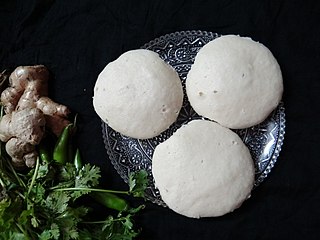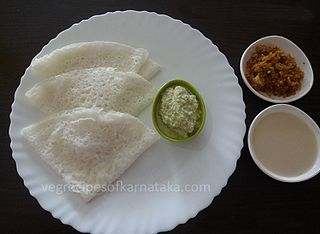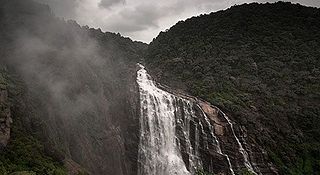
A dosa or dose is a thin pancake or crepe, originating from South India, made from a fermented batter predominantly consisting of lentils and rice. It is somewhat similar to a crepe in appearance, although savoury flavours are generally emphasized. Its main ingredients are rice and black gram, ground together in a fine, smooth batter with a dash of salt, then fermented. Dosas are a common dish in South Indian cuisine, but now have become popular all over the Indian subcontinent. Dosas are served hot along with chutney by tradition and sambar in recent times. Other accompaniments include chutney powder.

Idli or idly are a type of savoury rice cake, originating from the Indian subcontinent, popular as breakfast foods in Southern India and in Sri Lanka. The cakes are made by steaming a batter consisting of fermented black lentils (de-husked) and rice. The fermentation process breaks down the starches so that they are more readily metabolized by the body.

Sambar is a lentil-based vegetable stew, cooked with pigeon pea and tamarind broth. It is popular in South Indian and Sri Lankan cuisines.

Tamil cuisine is a culinary style originating in the southern Indian state Tamil Nadu and other parts of South Asia such as Sri Lanka. Vegetarian cuisine is popular among the Tamil people and has been so since ancient times. However, meats along with rice, legumes and lentils are also popular. Dairy products and tamarind are used to provide sour flavors. On special occasions, traditional Tamil dishes are served in a traditional manner, using banana leaves in place of utensils. After eating, the banana leaves are then used as a secondary food for cattle. A typical breakfast meal consists of idli or dosa with chutney. Lunch includes rice, sambar, curd, kuzhambu, and rasam.

Rasam, or charu pani, chaaru, saaru, saathamudhu, or kabir is a South Indian soup. It is a spicy-sweet-sour stock traditionally prepared using kokum, tamarind, or dried green mango juice as a base along with jaggery, garlic, black pepper, chili pepper, cumin, tomato, and other spices as seasonings. Steamed lentils can be added along with any preferred vegetables. Nowadays, all the seasonings required are combined and ground beforehand into rasam powder, which is available commercially. Chilled prepared versions are also marketed commercially as well as rasam paste in bottles.

Cuisine of the Indian subcontinent includes the cuisines from the Indian subcontinent comprising the traditional cuisines from Bangladesh, Bhutan, India, the Maldives, Nepal, Pakistan and Sri Lanka.

Idiyappam, also known as string hopper, nool puttu, or noolappam, chomai, indiappa is a rice noodle dish originating from the Indian states of Tamil Nadu and Kerala. Also in Srilanka. It consists of rice flour pressed into noodles, woven into a flat disc-like shape and steamed. The dish also spread to Southeast Asia, where it is called putu mayam in Malaysia and Singapore, putu mayang in Indonesia.

Udupi cuisine is a cuisine of South India. It forms an important part of Tuluva-Mangalorean cuisine and takes its name from Udupi, a city on the southwest coast of India in the Tulunadu region. Udupi cuisine has its origin in the Tulu Ashta Mathas of Udupi founded by Madhvacharya.

Indian breads are a wide variety of flatbreads and crêpes which are an integral part of Indian cuisine. Their variation reflects the diversity of Indian culture and food habits.

Neer dosa, literally meaning water dosa in Tulu, is a crêpe prepared from rice batter. Neer dosa is a delicacy from Tulu Nadu region, and part of Udupi - Mangalorean cuisine.

South Indian cuisine includes the cuisines of the five southern states of India—Andhra Pradesh, Karnataka, Kerala, Tamil Nadu and Telangana—and the union territories of Lakshadweep, Pondicherry, and the Andaman and Nicobar Islands.There are typically vegetarian and non-vegetarian dishes for all five states. Additionally, all regions have typical main dishes, snacks, light meals, desserts, and drinks that are well known in their respective region.

Sevai, shavige or santhakai, or Saemia is a type of rice vermicelli popular in Southern India, particularly Tamil Nadu, Karnataka and some parts of Kerala. While typically made from rice, varieties made out of other food grains like wheat, ragi, etc. can also be found. Sevai is popular throughout South India as a meal throughout the day.

Bisi bele bhath or Bisi Bele Huliyanna (ಬಿಸಿಬೇಳೆಹುಳಿಯನ್ನ) is a spicy, rice-based dish with origins in the state of Karnataka, India. It is said to have originated in the Mysore Palace and from there spread across the state of Karnataka.

Ragi Mudde, Ragi Sangati or kali and colloquially simply referred to as either 'Mudde' or 'Hittu' - i.e. flour); is a wholesome meal in the state of Karnataka and the Rayalaseema region in Andhra Pradesh. It is mainly popular with the rural folk of Karnataka. In Tamil Nadu, especially in Western Tamil Nadu it is called Ragi Kali. Ragi mudde main food in Kolar, Mandya, Hassan, Mysore, Tumkur districts in Karnataka.The Similar variation known as Dhindo is also eaten in Northeast India, Nepal and Bhutan.

Siddapur is a city and the headquarters of Siddapur taluk, located in the Uttara Kannada district of the state of Karnataka in southern India. It is nestled among the Western Ghats. The town is surrounded by forests and lush greenery, and the region is popular for its many waterfalls. Sirsi is the nearest large city. Adike is the primary crop grown in the villages that surround the town.

Saraswat cuisine is the cuisine of the Saraswat Brahmins from the Konkan region on the western coast of India. Saraswat cuisine differs within the Saraswat Brahmin subsects and within the Konkan-Canara region. Saraswat cuisine originally hails from the Konkan region including Uttara Kannada, Udupi district, Dakshina Kannada, Damaon, and Goa, India. Saraswat cuisine is known throughout the western coast of India. Each variation has its unique flavour and makes uses of different vegetables and fruits available in the region. Saraswat cuisine is usually pesco-vegetarian. This group regards fish meat in general as sea vegetables. Historically, they have refrained from eating any terrestrial animals.
Mangaloreans are a collection of diverse ethnic groups that hail from the historical locales of South Canara (Tulunaad) on the south western coast of Karnataka, India, particularly the residents native to Mangaluru.

Mangalorean cuisine is a collective name given to the cuisine of Mangalore which comprises cuisines like Udupi as well as cuisine of the Mangalorean communities like that of the Tuluvas, Goud Saraswat Brahmins, Mangalorean Catholics and the Bearys.

Telugu cuisine is a cuisine of South India native to the Telugu people from the states of Andhra Pradesh and Telangana. Generally known for its tangy, hot and spicy taste, the cooking is very diverse due to the vast spread of the people and varied topological regions.

Telangana cuisine is a food culture unique to Telangana Region. The Telangana state lies on the Deccan plateau and its topography dictates more millets and roti based dishes. Jowar and Bajra features more prominently in their cuisine. Due to its proximity with Maharashtra, Chhattisgarh and northwest Karnataka, it shares some similarities and differences of the Deccan Plateau cuisine.



























